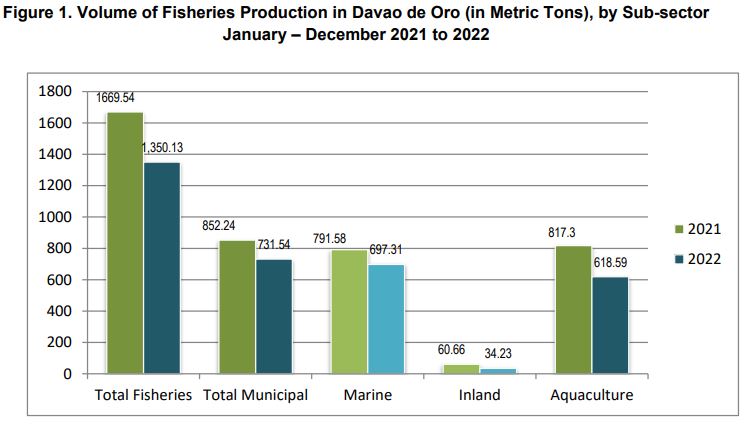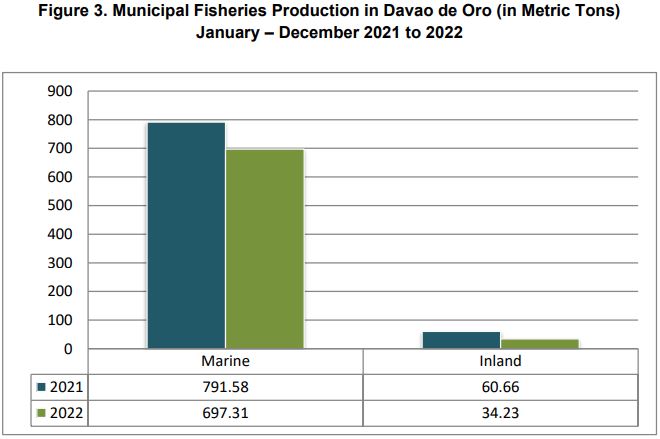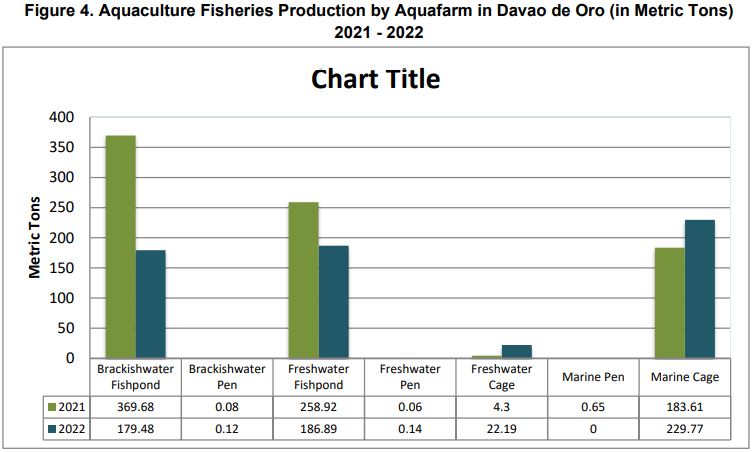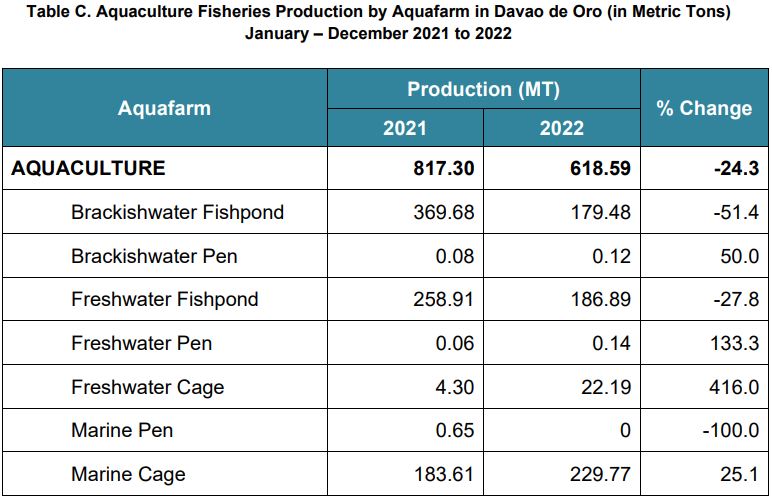VOLUME OF FISHERIES PRODUCTION IN DAVAO DE ORO
The total fisheries production in the province of Davao de Oro in 2022 was recorded at 1,350.13 metric tons from 1,669.54 metric tons output in 2021, representing an annual decrease of 19.13 percent. This was brought about by the decrease in production in all subsectors during the period. (see Table A)
The volume of fish production is contributed by three sub-sectors composed of commercial, municipal, and aquaculture. However, commercial fisheries are not applicable in Davao de Oro as the province has no commercial fishing operations.
In 2022, municipal fisheries, including marine and inland fishing, contributed 54.1 percent to total fisheries production. Marine municipal fishing accounted for 51.6 percent of this volume, while inland fishing contributed 2.5%. Aquaculture made up the remaining 45.8 percent.
MUNICIPAL FISHERIES PRODUCTION
The volume of production of municipal fisheries in Davao de Oro is comprised of marine municipal and inland municipal productions. In the year 2022, the total volume of production summed up to 731.54 metric tons. It decreases by -14.1 percent compared to 2021, with a production of 852.24 metric tons.
In the Quarterly Fisheries Survey in 2022, Davao de Oro's marine municipal production decreased by -11.9 percent over the year 2021. From 791.58 metric tons in 2021, it decreases to 697.31 metric tons in 2022. Inland municipal production also fell by -43.6 percent, dropping from 60.66 metric tons in 2021 to only 34.23 metric tons in 2022.
In 2022, the top three species caught in marine municipal were Bali Sardinella, Squid, and Big-eyed scad. Bali Sardinella was the most caught species with 52.98 metric tons, followed by Squid with 52.92 metric tons, and Big-eyed scad with 44.51 metric tons. Bali Sardinella experienced a negative growth rate of -28.0 percent compared to last year's catch of 73.61 metric tons. Meanwhile, Squid saw an increase in volume by 15.4 percent, from 45.86 metric tons in 2021 to 52.92 metric tons in 2022. Big-eyed scad showed a negative growth rate as well, producing 47.86 metric tons in the previous year.
AQUACULTURE FISHERIES PRODUCTION
The volume of production on Aquaculture fisheries in Davao de Oro posted a negative growth of 24.3 percent in 2022. From 817.30 metric tons recorded in the year 2021, it decreases to 618.59 metric tons in 2022.
Negative growth in production was recorded in brackishwater fishponds, freshwater fishponds, and marine pens in the aquaculture sector compared to the previous year. Brackishwater fishpond production decreased by -51.4% from 369.68 metric tons to 179.48 metric tons, and freshwater fishpond production decreased by -27.8% from 258.91 metric tons to 186.89 metric tons. There was no production caught in marine pens, resulting in a 100% decrease from 0.06 to 0 metric tons. However, positive growth was observed in brackishwater and freshwater pens, with brackishwater pens increasing by 50.0% from 0.08 metric tons in 2021 to 0.12 metric tons this year, and freshwater pens increasing by 133.3% from 0.06 metric tons to 0.14 metric tons this year. In addition, there was significant growth in the production of freshwater cages by 416.0% from 4.30 metric tons to 22.19 metric tons and marine cages by 25.1% from 183.61 metric tons to 229.77 metric tons in 2022. (see Figure 4 and Table C)
Technical Notes:
Commercial fishing – is the catching of fish with the use of fishing boats with a capacity of more than three gross tons for trade, business, or profit beyond subsistence or sports fishing.
Municipal Fishing - covers fishing operations carried out with or without the use of a boat weighing three gross tons or less.
Inland Municipal Fishing - the catching of fish, crustaceans, mollusks, and all other aquatic animals and plants in inland water like lakes, rivers, dams, marshes, etc. using simple gear and fishing boats some of which are non-motorized with a capacity of three gross tons or less; or fishing not requiring the use of fishing boats.
Aquaculture - fishery operation involving all forms of raising and culturing of fish and other fishery species in marine, brackish, and freshwater environments. Examples are fishponds, fish pens, fish cages, mussels, oysters, seaweed farms, and hatcheries.
Aquafarm - the farming facilities used in the culture or propagation of aquatic species including fish, mollusks, crustaceans, and aquatic plants for purposes of rearing to enhance production.
Brackish water – is a mixture of seawater and freshwater with salinity that varies with the tide. Examples are estuaries, mangroves, and the mouths of rivers where seawater enters during high tide.
Fisheries - all activities relating to the act or business of fishing, culturing, preserving, processing, marketing, developing, conserving, and managing aquatic resources and the fishery areas including the privilege to fish or take aquatic resources thereof (RA 8550).
Fisheries Sector - the sector engaged in the production, growing, harvesting, processing, marketing, developing, conserving, and managing of aquatic resources and fishery areas.
Fish Cage - stationary or floating fish enclosure made of synthetic net wire/bamboo screen or other materials set in the form of an inverted mosquito net ("happy" type) with or without cover with all sides either tied to poles stacked to the water bottom or with anchored floats for aquaculture purposes.
Fishing Gear - any instrument or device and its accessories utilized in taking fish and other fishery species.
Fishing Grounds - areas in any body of water where fish and other aquatic resources congregate and become the targets of capture.
Fish Pen - an artificial enclosure constructed within a body of water for culturing fish and fishery/ aquatic resources made up of bamboo poles closely arranged in an enclosure with wooden materials, screen, or nylon netting to prevent the escape of fish.
Fishpond - a body of water (artificial or natural) where fish and other aquatic products are cultured, raised or cultivated under controlled conditions. This island-based type of aquafarm. Note that the setting-up of fish cages in ponds does not make the operation of the fish cage at the same time a fishpond.
Freshwater – is water without salt or marine origins, such as generally found in lakes, rivers, canals, dams, reservoirs, paddy fields, and swamps.
Landing Center – a place where the fish catch and other aquatic products are unloaded and traded.







